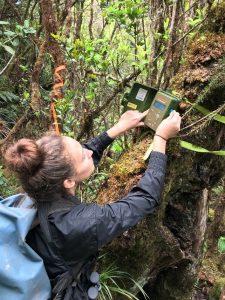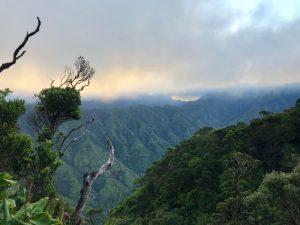-
About
- Leadership & Faculty
- News & Events
-
Academics
- Graduate
- Advanced Clinical Training
- Continuing Education
-
Student Life
-
Research
-
Hospitals & Clinics
- Emergency Care
- Hospital Services
-
Community Outreach
- Volunteer
A Survival Guide for Field Work in the Alakai Wilderness Preserve
Dayna Martinez, MCM’19 Discusses her Winter Externship with the Kaua’i Forest Bird Recovery Project in Kaua’i, Hawai’i
As a master’s candidate in Tufts conservation medicine (MCM) program, I was able to spend my winter break in Kaua’i, Hawai’i volunteering with a non-profit organization called Kaua’i Forest Bird Recovery Project (KFBRP). I was able to experience the one-health paradigm as it relates to conservation. Many of the native plants and wildlife hold important ecological and cultural significance to the people of the Hawaiian Archipelago, making the conservation of species vital.
Jewels of the Forest
History describes ancient Hawaiian royalty adorning themselves in brightly colored feathers of forest song birds. Gold and semi-precious stones were not found on the islands, so many considered these vivid birds the jewels of the forest. Native birds such as the ‘i’iwi, ‘apapane, and ‘elepaio have been mentioned in Hawaiian legends and mele, which are stories told through singing, chanting, or in the form of poetry.
Today in Kauai, the ‘akikiki, ‘akeke’e, and puaiohi are all federally listed as endangered; with the ‘i’iwi listed as threatened. All four of the birds have been restricted to habitats in higher elevation due to deforestation, the destruction of habitat through the introduction of invasive plants, predation caused by invasive rodents and feral cats, and mosquito borne disease. KFBRP and its partners have implemented a number of strategies to reduce predation, to provide safe nesting habitat, and to monitor bird populations.
All in a Day’s (Field)Work
At the first sign of daylight I crawled out of my warm sleeping bag to meet the brisk morning air. In the Alaka’i Wilderness, night-time and early morning temperatures can reach about 35ᵒF. Replace your swimsuit for a warm hat and gloves, you’ll thank me later. The team and I moved around camp checking batteries and equipment we’d need for the day, packing our daypacks, making breakfast, and taking turns using our compost bucket bathroom which can be best described as rustic.
6 Things You Should Have in Your Daypack
1)Emergency Kit- include a first aid kit, flint, compass, emergency transponder, head lamp and satellite communication device
2) Field Equipment- camera traps, song-meters, and waterproof writing materials
3) Rain gear and an extra set of clothing- you can never be too safe during the rainy season
4) Lunch and plenty of water- to keep your energy and stay hydrated
5) GPS unit- although, you should probably have that on hand and easily accessible
6) Binoculars- duh!
As our team trekked the unmaintained forest trails, we examined the rodent traps that had been placed previously. Birds like the puaiohi are at risk of predation by three species of rats that have been introduced to the island. These rats climb into the nests and eat the eggs, hatchlings, and even incubating females, impacting already vulnerable bird populations. Predator control has become an important strategy in conserving Kaua’i’s native birds and will continue to be vital as humans introduce foreign species to the island. Our team also deployed camera traps at these sites so we could monitor the efficacy of the rodent traps and ensure that these traps were not harming native wildlife. In addition to monitoring rodent traps, we were also charged with the task of deploying song-meters. Song-meters are acoustic recorders that allow us to monitor the birds by picking up and recording sounds such as bird calls and songs. These devices have highly sensitive microphones and were especially helpful in detecting elusive species such as the ‘akikiki and ‘akeke’e. But have an expert with you, these two bird species sound very similar to the untrained ear!
As the day went on, we climbed up steep ridges and down deep valleys. And no matter how cautious we were at traversing streams, one of us always managed to slip on an algae covered rock, soaking our pa
nts and filling our rubber boots with water. Our work continued and the weather became warm. I couldn’t tell if I was damp from perspiration or my most recent fall in the stream. At the end of the day all of us were muddy and soaked in sweat, just thinking about getting back to camp to make tacos for dinner. Camp meals proved to be a time for us to unwind from the day’s hardships and allowed us to learn about each other. Dinner also motivated us in getting to camp on time for the evening; our campsite had an overlook with decent cellphone reception, and a spectacular view. After a day of field work, as the sun sets and temperatures drop, I highly recommend a hot protein packed meal to share with your fellow wildlife biologists.
Camp Cooking 101
Fun fact: because of the cooler temperatures at high elevation, many produce items will stay fresh during most of your trip allowing you to cook a delicious meal on your camp stove.
Spicy Tofu Curry
| -1 small onion
-1 bell pepper -Half a carrot -1 water-free block of tofu -1 package of pre-made curry sauce -Rice |
-Filtered or boiled water
-Salt -Curry powder -Sriracha sauce -Cooking oil
|
1)Prepare rice. You can use unfiltered water; just be sure it comes to a full boil.
2) Coarsely chop onion, pepper, and carrot.
3) Cook in oil with salt and curry powder until tender.
4) Cube tofu and toss with pepper mixture. Season with salt and curry powder.
5) Add curry sauce and cook until heated.
6) Serve on a bed of rice. Top with sriracha, optional.
7) Add starchy rice water to your dishwashing bucket. It’s no fun washing dishes in cold water.
More Tips & Tricks for Life in the Field
-Rubber boots are best for the muddy terrain and crossing streams
-Pack light, but bring extra socks
-Always wear sunscreen
-Never hike unfamiliar areas alone
-When showering is unavailable, baby wipes are your best friend
-Have a good sense of humor and positive outlook; you’re going to be pooping in a bucket and falling in streams, but you’re doing your part to save Kaua’i’s endangered birds
My time with KFBRP helped me gain a profound respect for not just the wildlife, but also for the dedicated conservationists and the communities who find great significance in these natural ecosystems. I am grateful to have had this learning opportunity, for this experience has made me a stronger, more well-rounded scientist.

